The global superconducting detector market is valued at USD 112.4 million in 2025 and is projected to reach USD 381.7 million by 2035, growing at a CAGR of 13.0% and expanding by nearly 3.4X during the period. Regional trends indicate uneven growth patterns as adoption depends heavily on research infrastructure, quantum technology funding, and industrial integration.
North America is expected to remain the leading region, driven by strong federal funding for quantum research, defense modernization, and advanced medical imaging systems. The United States is home to several national laboratories and private-sector initiatives focusing on quantum computing and superconducting electronics, ensuring consistent demand for ultra-sensitive detectors. Collaborations between universities, technology companies, and defense agencies further support commercial deployment in both aerospace and telecommunications.
Europe is likely to follow closely, supported by EU-level quantum technology initiatives and investments in photonics and particle research. Countries such as Germany, France, and the UK are advancing large-scale projects in quantum communication and superconducting circuits, creating steady demand for detectors that enable ultra-low noise measurements. Europe’s strong focus on medical imaging and high-energy physics also sustains market growth, particularly through CERN-related projects and healthcare innovation clusters.
Asia Pacific is projected to record the fastest growth, supported by rising investment in quantum technology ecosystems in China, Japan, and South Korea. China is making rapid progress in quantum communication and high-energy physics research, where superconducting detectors play a critical role. Japan’s strong electronics sector and South Korea’s semiconductor innovation provide further momentum, with companies integrating superconducting sensors into next-generation devices and national research programs. India and Singapore are also emerging contributors, particularly in academic and defense research.
The Middle East and Latin America are expected to contribute smaller shares but are gradually building demand through niche projects. The Middle East, particularly the UAE and Saudi Arabia, is exploring investments in advanced research infrastructure, and superconducting detectors may see application in aerospace and defense. Latin America, with Brazil leading in scientific research, shows incremental demand tied to academic projects and international collaborations in physics and material sciences.North America and Europe are expected to retain leadership due to strong institutional frameworks, while the Asia Pacific emerges as the high-growth frontier through large-scale state-backed investments and industrial scaling. The Middle East and Latin America will remain limited but evolving markets, contributing to global adoption at a slower pace.
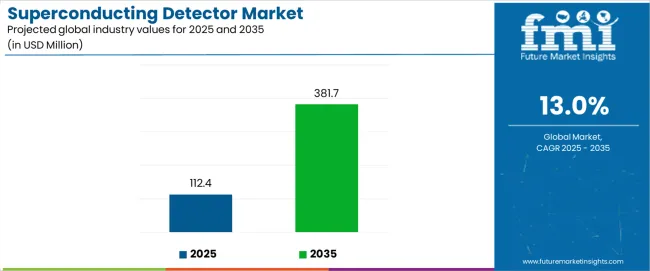
Between 2025 and 2030, the superconducting detector market is projected to expand from USD 112.4 million to USD 183.3 million, resulting in a value increase of USD 70.9 million, which represents 26.3% of the total forecast growth for the decade. This phase of development will be shaped by increasing demand for quantum technology applications, rising research activity enabling advanced detection techniques, and growing availability of cryogenic cooling systems across quantum computing operations and scientific research facilities.
Between 2030 and 2035, the market is forecast to grow from USD 183.3 million to USD 381.7 million, adding another USD 198.4 million, which constitutes 73.7% of the overall ten-year expansion. This period is expected to be characterized by the advancement of integrated quantum systems, the integration of AI-enhanced signal processing for detector optimization, and the development of room-temperature superconducting technologies across diverse quantum applications. The growing emphasis on quantum communication networks and ultra-precise measurement systems will drive demand for advanced detector varieties with enhanced sensitivity capabilities, improved detection efficiency characteristics, and superior performance profiles.
Between 2020 and 2024, the superconducting detector market experienced accelerated growth, driven by increasing quantum research investments and growing recognition of superconducting technology's effectiveness in delivering unparalleled detection sensitivity across quantum computing and telecommunications applications. The market developed as researchers recognized the potential for advanced detectors to deliver breakthrough performance while meeting modern requirements for single-photon detection and ultra-low noise measurement operations. Technological advancement in nanofabrication processes and cryogenic system design began emphasizing the critical importance of maintaining detection accuracy while enhancing system reliability and improving signal-to-noise ratios.
| Metric | Value |
|---|---|
| Estimated Value in (2025E) | USD 112.4 million |
| Forecast Value in (2035F) | USD 381.7 million |
| Forecast CAGR (2025 to 2035) | 13.0% |
From 2030 to 2035, the market is forecast to grow from USD 183.3 million to USD 381.7 million, adding another USD 198.4 million, which constitutes 73.7% of the overall ten-year expansion. This period is expected to be characterized by the advancement of quantum-enhanced detection algorithms, the integration of automated calibration systems for measurement precision, and the development of specialized detector arrays for enhanced detection capabilities. The growing emphasis on quantum advantage applications and operational scalability will drive demand for premium varieties with enhanced temperature stability credentials, improved integration options, and superior functionality characteristics.
Between 2020 and 2024, the superconducting detector market experienced robust growth, driven by increasing awareness of quantum technology benefits and growing recognition of detector systems' effectiveness in supporting efficient quantum communication across research institutions and commercial quantum computing services. The market developed as users recognized the potential for specialized detectors to deliver performance advantages while meeting modern requirements for quantum state measurement and reliable photon counting performance. Technological advancement in superconducting material engineering and detector fabrication processes began emphasizing the critical importance of maintaining quantum coherence while extending detector operational life and improving measurement accuracy across diverse quantum applications.
Market expansion is being supported by the increasing global demand for quantum computing solutions and the corresponding shift toward high-performance detectors that can provide superior quantum measurement characteristics while meeting user requirements for system reliability and cost-effective quantum operations. Modern quantum researchers are increasingly focused on incorporating detector systems that can enhance quantum state fidelity while satisfying demands for precise, ultra-sensitive photon detection and optimized quantum information processing practices. Superconducting detectors' proven ability to deliver quantum-grade sensitivity, low dark count rates, and diverse quantum application possibilities makes them essential components for quantum computing developers and precision-focused research professionals.
The growing emphasis on quantum communication networks and system optimization is driving demand for high-performance detector systems that can support distinctive quantum outcomes and comprehensive system protection across quantum cryptography, quantum sensing, and quantum computing applications. User preference for detectors that combine quantum excellence with operational flexibility is creating opportunities for innovative implementations in both traditional research and emerging commercial quantum applications. The rising influence of quantum internet infrastructure and advanced quantum technologies is also contributing to increased adoption of specialized detectors that can provide authentic quantum performance benefits and reliable operational characteristics.
The market is segmented by technology, application, temperature range, sensitivity level, and region. By technology, the market is divided into SNSPD (single Photon Superconducting Nanowire Detectors), TES (Transition Edge Sensors), STJ (Superconducting Tunnel Junctions), and others. Based on application, the market is categorized into quantum technology, medical imaging, industrial sensing, aerospace applications, and others. By temperature range, the market includes ultra-low temperature (sub-Kelvin), liquid helium temperature (4K), liquid nitrogen temperature (77K), and high-temperature superconducting detectors. By sensitivity level, the market encompasses single-photon detection, few-photon detection, and multi-photon detection systems. Regionally, the market is divided into Asia Pacific, North America, Europe, Latin America, Middle East & Africa, and other regions.
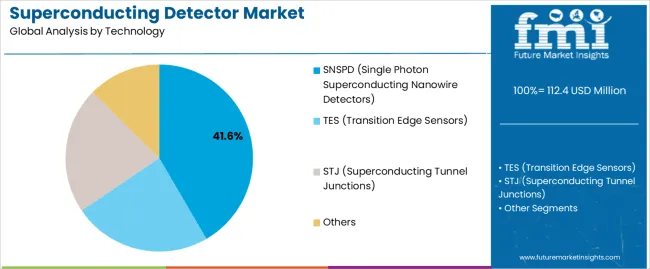
The SNSPD (single Photon Superconducting Nanowire Detectors) segment is projected to account for 41.6% of the superconducting detector market in 2025, reaffirming its position as the leading product category. Quantum researchers and technology developers increasingly utilize SNSPD systems for their superior detection efficiency characteristics, established quantum performance standards, and essential functionality in diverse quantum applications across multiple research types. SNSPD systems' proven performance characteristics and established cost-effectiveness directly address user requirements for reliable single-photon detection and optimal quantum measurement precision in commercial applications.
This product segment forms the foundation of modern quantum detection performance patterns, as it represents the component category with the greatest quantum sensitivity potential and established compatibility across multiple quantum systems. Research investments in advanced nanowire technology and detection efficiency optimization continue to strengthen adoption among precision-conscious quantum developers. With users prioritizing quantum fidelity and detection reliability, SNSPD systems align with both research objectives and performance requirements, making them the central component of comprehensive quantum measurement strategies.
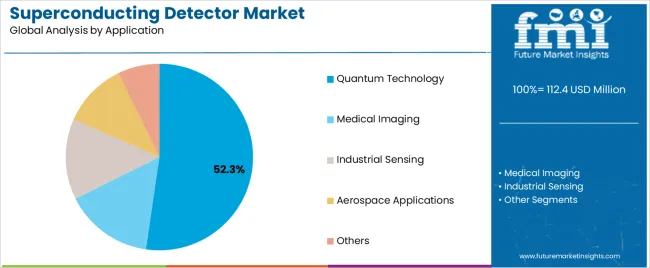
Quantum technology is projected to represent 52.3% of the superconducting detector market in 2025, underscoring its critical role as the primary application for performance-focused researchers seeking superior quantum measurement benefits and enhanced research completion credentials. Quantum computing developers and research professionals prefer quantum technology applications for their established research volumes, proven market demand, and ability to maintain exceptional measurement quality while supporting versatile detection requirements during diverse quantum projects. Positioned as essential applications for precision-conscious researchers, quantum technology offerings provide both operational excellence and competitive positioning advantages.
The segment is supported by continuous improvement in quantum computing technology and the widespread availability of established research standards that enable quality assurance and premium positioning at the research level. Additionally, quantum technology companies are optimizing detector selections to support research differentiation and competitive performance strategies. As quantum technology continues to advance and researchers seek efficient detection methods, quantum technology applications will continue to drive market growth while supporting innovation development and research satisfaction strategies.
The superconducting detector market is advancing rapidly due to increasing quantum computing consciousness and growing need for precision detection solutions that emphasize superior performance outcomes across quantum segments and research applications. However, the market faces challenges, including competition from alternative detection technologies, cryogenic system complexities, and component cost pressures affecting operational economics. Innovation in quantum integration and advanced materials continues to influence market development and expansion patterns.
The growing adoption of superconducting detectors in quantum computing projects and quantum communication networks is enabling researchers to develop quantum measurement strategies that provide distinctive performance benefits while commanding competitive positioning and enhanced research completion characteristics. Quantum applications provide superior detection sensitivity while allowing more sophisticated measurement control features across various quantum categories. Users are increasingly recognizing the operational advantages of detector positioning for premium quantum outcomes and precision-conscious research integration.
Modern superconducting detector manufacturers are incorporating advanced signal processing technologies, ai-driven noise reduction systems, and automated calibration tracking to enhance measurement precision, improve detection efficiency, and meet commercial demands for intelligent quantum measurement solutions. These systems improve operational effectiveness while enabling new applications, including quantum error correction programs and performance optimization protocols. Advanced processing integration also allows researchers to support quantum leadership positioning and measurement assurance beyond traditional detection operations.
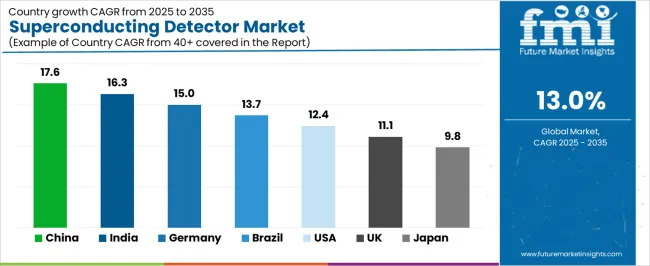
| Country | CAGR (2025-2035) |
|---|---|
| China | 17.6% |
| India | 16.3% |
| Germany | 15.0% |
| Brazil | 13.7% |
| USA | 12.4% |
| UK | 11.1% |
| Japan | 9.8% |
The superconducting detector market is experiencing robust growth globally, with China leading at a 17.6% CAGR through 2035, driven by the expanding quantum technology sector, growing research investments in quantum computing, and increasing adoption of advanced detection systems. India follows at 16.3%, supported by rising quantum research initiatives, expanding technology development sector, and growing acceptance of precision detection solutions. Germany shows growth at 15.0%, emphasizing established quantum research capabilities and comprehensive detection technology development. Brazil records 13.7%, focusing on quantum research expansion and technological advancement growth. The USA demonstrates 12.4% growth, prioritizing advanced quantum technologies and detection optimization.
The report covers an in-depth analysis of 40+ countries top-performing countries are highlighted below.
Revenue from superconducting detector consumption and sales in China is projected to exhibit exceptional growth with a CAGR of 17.6% through 2035, driven by the country's rapidly expanding quantum technology sector, favorable government policies toward quantum research development, and initiatives promoting advanced detection technologies across major research regions. China's position as a leading quantum computing hub and increasing focus on quantum communication systems are creating substantial demand for high-quality superconducting detectors in both research and commercial markets. Major quantum technology companies and research institutions are establishing comprehensive detector capabilities to serve growing demand and emerging quantum opportunities.
Revenue from superconducting detector products in India is expanding at a CAGR of 16.3%, supported by rising quantum research investment, growing technology development initiatives, and expanding research institution capabilities. The country's developing quantum sector and increasing government investment in advanced detection technologies are driving demand for superconducting detectors across both traditional and modern quantum applications. International quantum technology companies and domestic research institutions are establishing comprehensive operational networks to address growing market demand for precision detectors and efficient quantum solutions.
Revenue from superconducting detector products in Germany is projected to grow at a CAGR of 15.0% through 2035, supported by the country's mature quantum research sector, established detection standards, and leadership in quantum technology. Germany's sophisticated research infrastructure and strong support for advanced quantum systems are creating steady demand for both traditional and innovative detector varieties. Leading quantum technology manufacturers and specialty research institutions are establishing comprehensive operational strategies to serve both domestic markets and growing export opportunities.
Revenue from superconducting detector products in Brazil is projected to grow at a CAGR of 13.7% through 2035, driven by the country's emphasis on quantum research expansion, technology development, and growing research institution capabilities. Brazilian researchers and quantum technology companies consistently seek precision-grade detectors that enhance research efficiency and support operational excellence for both traditional and modern quantum applications. The country's position as a Latin American quantum research leader continues to drive innovation in specialized detector applications and commercial quantum standards.
Revenue from superconducting detector products in the USA is projected to grow at a CAGR of 12.4% through 2035, supported by the country's emphasis on quantum technology advancement, detection optimization, and advanced quantum integration requiring efficient detector solutions. American researchers and quantum users prioritize performance reliability and operational precision, making specialized detectors essential components for both traditional and modern quantum applications. The country's comprehensive quantum leadership and advancing detection patterns support continued market expansion.
Revenue from superconducting detector products in the UK is projected to grow at a CAGR of 11.1% through 2035, supported by established quantum research standards, mature technology markets, and emphasis on detection reliability across commercial and research sectors. British researchers and quantum professionals prioritize quality performance and operational consistency, creating steady demand for premium detector solutions. The country's comprehensive market maturity and established quantum practices support continued development in specialized applications.
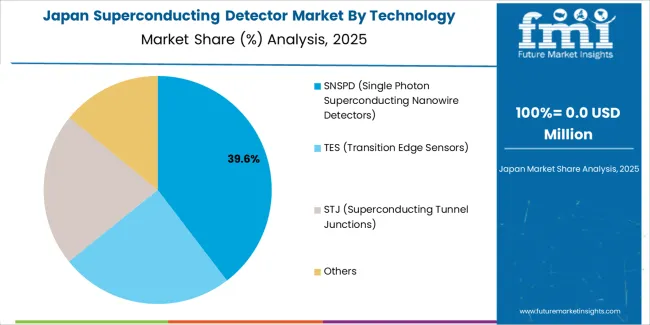
Revenue from superconducting detector products in Japan is projected to grow at a CAGR of 9.8% through 2035, supported by the country's emphasis on precision manufacturing, quality excellence, and advanced technology integration requiring efficient detector solutions. Japanese businesses and research users prioritize technical performance and manufacturing precision, making specialized detectors essential components for both traditional and modern quantum applications. The country's comprehensive quality leadership and advancing quantum patterns support continued market expansion.
The Europe superconducting detector market is projected to grow from USD 29.8 million in 2025 to USD 101.4 million by 2035, recording a CAGR of 13.0% over the forecast period. Germany leads the region with a 35.8% share in 2025, moderating slightly to 35.2% by 2035, supported by its strong quantum research base and demand for premium, technically advanced detection equipment. The United Kingdom follows with 24.2% in 2025, easing to 23.8% by 2035, driven by a mature quantum research market and emphasis on detection reliability and performance optimization. France accounts for 16.5% in 2025, rising to 17.1% by 2035, reflecting steady adoption of quantum computing solutions and operational efficiency enhancement. Italy holds 12.3% in 2025, expanding to 13.0% by 2035 as quantum research initiatives and specialty detection applications grow. Spain contributes 6.8% in 2025, growing to 7.1% by 2035, supported by expanding quantum technology sector and equipment modernization. The Nordic countries rise from 3.2% in 2025 to 3.4% by 2035 on the back of strong quantum technology adoption and advanced detection methodologies. BENELUX remains at 1.2% share across both 2025 and 2035, reflecting mature, precision-focused research markets.
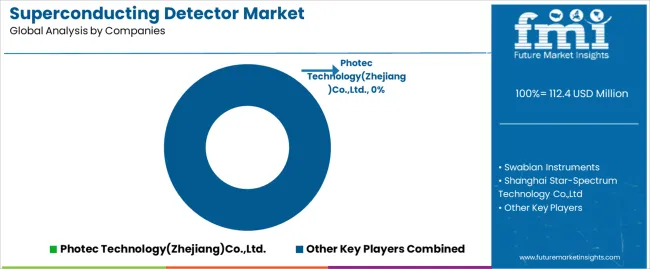
The superconducting detector market is characterized by competition among established quantum technology manufacturers, specialized detector producers, and integrated quantum solution companies. Companies are investing in precision fabrication technologies, advanced material development systems, product innovation capabilities, and comprehensive distribution networks to deliver consistent, high-quality, and reliable superconducting detector systems. Innovation in sensitivity enhancement, quantum efficiency optimization, and application-specific product development is central to strengthening market position and customer satisfaction.
Photec Technology(Zhejiang)Co.,Ltd. leads the market with a strong focus on quantum technology innovation and comprehensive superconducting detector solutions, offering commercial detection systems with emphasis on manufacturing excellence and technological heritage. Swabian Instruments provides specialized quantum detectors with a focus on research market applications and performance engineering networks. Shanghai Star-Spectrum Technology Co.,Ltd delivers integrated quantum solutions with a focus on research positioning and operational efficiency. single Quantum specializes in comprehensive single-photon detector systems with an emphasis on precision applications. Photonteck focuses on comprehensive quantum detection solutions with advanced design and premium positioning capabilities.
The success of superconducting detectors in meeting commercial quantum demands, researcher-driven precision requirements, and performance integration will not only enhance quantum measurement outcomes but also strengthen global quantum technology manufacturing capabilities. It will consolidate emerging regions' positions as hubs for efficient detector production and align advanced economies with commercial quantum systems. This calls for a concerted effort by all stakeholders -- governments, industry bodies, manufacturers, distributors, and investors. Each can be a crucial enabler in preparing the market for its next phase of growth.
How Governments Could Spur Local Production and Adoption?
How Industry Bodies Could Support Market Development?
How Distributors and Quantum Industry Players Could Strengthen the Ecosystem?
How Manufacturers Could Navigate the Shift?
| Items | Values |
|---|---|
| Quantitative Units (2025) | USD 112.4 million |
| Technology | SNSPD (single Photon Superconducting Nanowire Detectors), TES (Transition Edge Sensors), STJ (Superconducting Tunnel Junctions), Others |
| Application | Quantum Technology, Medical Imaging, Industrial Sensing, Aerospace Applications, Others |
| Temperature Range | Ultra-Low Temperature (Sub-Kelvin), Liquid Helium Temperature (4K), Liquid Nitrogen Temperature (77K), High-Temperature Superconducting Detectors |
| Sensitivity Level | single-Photon Detection, Few-Photon Detection, Multi-Photon Detection Systems |
| Regions Covered | Asia Pacific, North America, Europe, Latin America, Middle East & Africa, Other Regions |
| Countries Covered | China, India, Germany, Brazil, United States, United Kingdom, Japan, and 40+ countries |
| Key Companies Profiled | Photec Technology(Zhejiang)Co.,Ltd., Swabian Instruments, Shanghai Star-Spectrum Technology Co.,Ltd, single Quantum, Photonteck, and other leading superconducting detector companies |
| Additional Attributes | Dollar sales by technology, application, temperature range, sensitivity level, and region; regional demand trends, competitive landscape, technological advancements in detector engineering, precision manufacturing initiatives, quantum efficiency enhancement programs, and premium product development strategies |
The global superconducting detector market is estimated to be valued at USD 112.4 million in 2025.
The market size for the superconducting detector market is projected to reach USD 381.7 million by 2035.
The superconducting detector market is expected to grow at a 13.0% CAGR between 2025 and 2035.
The key product types in superconducting detector market are snspd (single photon superconducting nanowire detectors), tes (transition edge sensors), stj (superconducting tunnel junctions) and others.
In terms of application, quantum technology segment to command 52.3% share in the superconducting detector market in 2025.






Full Research Suite comprises of:
Market outlook & trends analysis
Interviews & case studies
Strategic recommendations
Vendor profiles & capabilities analysis
5-year forecasts
8 regions and 60+ country-level data splits
Market segment data splits
12 months of continuous data updates
DELIVERED AS:
PDF EXCEL ONLINE
Superconducting Quantum Chip Market Size and Share Forecast Outlook 2025 to 2035
Superconducting Materials Market Size and Share Forecast Outlook 2025 to 2035
Superconducting Magnets Market Growth – Trends & Forecast 2025 to 2035
Superconducting Wire Market
XEDS Detectors Market Size and Share Forecast Outlook 2025 to 2035
Radar Detectors Market Size and Share Forecast Outlook 2025 to 2035
Flame Detector Market Size and Share Forecast Outlook 2025 to 2035
Smoke Detector Market Insights – Growth & Forecast through 2034
Cable Detector Market
AI-Powered Age Detection – Future of Digital Verification
Quantum Detector Market Size and Share Forecast Outlook 2025 to 2035
Voltage Detector Market Size and Share Forecast Outlook 2025 to 2035
Neutron Detectors Market Analysis - Size, Growth, and Forecast 2025 to 2035
Chemical Detector Market Size and Share Forecast Outlook 2025 to 2035
RF Power Detector Market
Explosive Detectors Market Size and Share Forecast Outlook 2025 to 2035
Total Dust Detector Market Size and Share Forecast Outlook 2025 to 2035
Food Metal Detector Market Size and Share Forecast Outlook 2025 to 2035
Vacuum Leak Detectors Market Size and Share Forecast Outlook 2025 to 2035
Buried Leak Detector Market Size and Share Forecast Outlook 2025 to 2035

Thank you!
You will receive an email from our Business Development Manager. Please be sure to check your SPAM/JUNK folder too.
Chat With
MaRIA